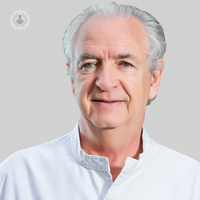All you need to know about tooth decay, FAQs
Written by:
A / How originates Caries?
Tooth decay is one of the most common problems in consultation Odontólogo. Its origin can be for several reasons:
1) The individual biotype known as "positive cariogenic" because:
- It has a deficit patient's immune system against cariogenic bacteria that colonize the dental Palca.
- A poor flow of dry mouth or salivation with little salivation. Saliva is not able to clean, moisten and protect teeth.
- A defective buffer system, leaving delaying recovery and lower the pH below 5'5 and increasing the dissolution of teeth in places where not remove saliva (interdental spaces, Fig. No. 5)). It is increased by the eating habits of the individual as discussed later.
- Molars with deep pits that hold food and is difficult to remove. Very common in children and young (immature enamel with unsealed tanks), Fig. No. 4.
- Malposition of teeth in their corresponding arches so the self-cleansing deteriorates, leaving many food remnants trapped between them. Promote tooth decay in the contact points (Fig. No. 5)
- desiccated mouth breather by saliva on the teeth preventing its removal and subsequent bacterial culture.
- Abnormally teeth structure either enamel (amelogenesis imperfecta) or dentin (dentinogenesis imperfecta).
- newly erupted teeth because their enamel is still immature because their ladrillitos (hexagonal hydroxyapatite crystallites) have to grow and become more resistant to an acid attack by a low pH.
- metabolic diseases such as diabetes.
2) Eating habits that cause cavities:
- Eating several times a day (at each meal low pH one point.)
Sweets, candy or sugar in general, if only one cookie at odd times
Foods rich in sugars such as (gasoline for bacteria of caries):
- Cakes, pastries, chocolate, etc.. in desserts.
- pasta, rice, bread, etc.
- pasty food
- soda drinks like Coca-Cola, citrus.
- Citrus fruits and juices.
- Vinegar in the salad.
3) Hygienic habits that cause cavities:
No brushing teeth allow dental plaque is established quickly and injure teeth
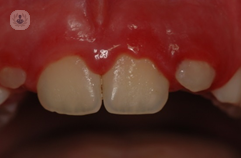
Dental plaque in the semi-erupted central incisor of a child.
- Especially in children with primary teeth because their enamel is immature and not very compact.
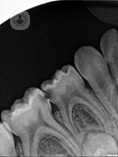
Rx bite fin in a child where a dark lesion is seen at the point of contact of the molars, are interproximal caries clinically often undetected.
- Also in the final in both the enamel crowns in youth and exposed roots (frequent in the adult) teeth.
- insufficiently brushing teeth cariogenic positive patients. Oral hygiene must be learned and controlled by the professional. Everyone needs a custom method. When there are more than a thousand prototypes toothbrush is because there is no universal one for all !.
- psycho-physical impairments that prevent oral hygiene. Need for trained help ..
B / What age can cause cavities ?:
Cavities can occur at any age but most often in childhood and youth as the enamel is immature and vulnerable to acid.
C / How caries diagnosed ?:
Cavities can be diagnosed:
- Keep in mind that tooth decay in origin, ie the enamel can not be diagnosed clinically except for white spots produced by vestibular in different periods of its eruption (parallel to the gingival margin lines). Also around the post orthodontic braces. At this stage you can remineralize and be reversible.
- Exploration in the mouth with the help of a professional dental probe. If it is trapped in a crack, pit or interdental space, it is a sign of decay.
- Visually:
- by changes of normal tooth color, very common in pits
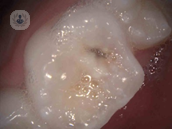 dark and whitish grave in occlusal pit. The probe also was trapped
dark and whitish grave in occlusal pit. The probe also was trapped - Tooth breakage: The patient comes for noticing something and appreciate in dental caries break
- Aparatología in consultation with a qualified professional dentalpor:
- Transillumination a color change is observed in an area of the tooth. When in doubt intraoral radiography bite fin is made.
- With intraoral Rx: Radiologically and precise techniques decay is detected when it has already drilled the enamel and dentin is (at this stage is irreversible). In the X-ray observed a dark spot where it should be light gray. Ideally bitewing radiographs are fin as the RX No. 1 Rxnº2 posterior and anterior area.
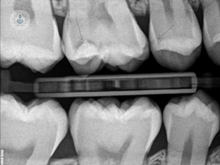
Arrows indicate No. 1 Rx decalcified carious areas of lower incisors Rx No. 2 Gimenez Alba
D / How can we know that we have a cavity ?:
First we can not notice any discomfort but if we see color changes in the crowns (Fig.Nº9) or even broken tooth or a piece of food trapped between teeth as previously happened.
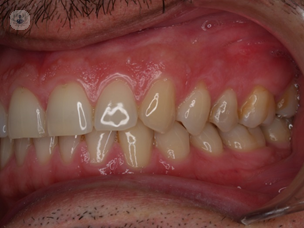
Color change in the 2nd upper premolar Izquierdo.
In other situations upset or hurt us with cold, or with food and especially with sugary foods. The presence of pain is not always constant so it is a late sign and a highly evolved or decay. The absence of discomfort-pain is not a sign of health.
E / Is the cavities are contagious ?:
Caries is a specific infection of the teeth as described previously but is not contagious like a cold, measles, etc.. The bacteria remain in the mouth and it is only necessary to settle forming plaque with biotype prone.
F / What habit hygienes need ?:
Normally, in patients without problems, and reviewed by the professional, once a day would be enough. Note that lasts approximately 3 minutes in the adult for the 4 quadrants normal oral hygiene and tongue. On the positive cariogenic patients need it after each intake (at least after meals).
In children, it is important to start early just to catch the habit and never skip brushing before bedtime. is recommended fluorine rich dentifrices as fluorine transforms enamel hydroxyapatite fluorhydroxyapatite that is more resistant to acid. This property can be supplemented with fluorinated mouthwashes and oral. Beware of overdosing orally that can intoxicate tooth formation known as dental hiperfluorosis (gray to dark and veined difficult to whiten teeth).
For the dental-oral hygiene we need to have several materials such as:
- Toothbrush. There are hundreds of shapes, sizes and textures. Search for the best and advised by the professional.
- dental toothpaste. For children and adolescents with fluorine. Whenever a pathology diagnosis is not specifically. Professional he decides.
- mouthwashes. As in toothpastes or dental pulps.
- Floss. Begin in adolescence and thus prevents interproximal caries.
- Cepillitos interdental in separate spaces.
- dental stick as a resource away from home. Best softwood like plane.
- Special irrigators mind orthodontic treatments, and adults on.
- tongue scraper. For all ages since language is a reservoir of dental plaque and if you do not brush at the end hygiene teeth immediately recolonize.
G / How is caries ?:
Tooth decay is treated by removing the damaged and infected then be able to restore the tooth to its proper shape and to be with their color tissue. First cavities if diagnosed early can preserve the vital pulp tissue, ie we preserve the vitality of the tooth and in these cases almost 98% of the time need dental anesthesia (infiltration or nerve block).
For infiltrative anesthesia intervention is needed or truncal tooth. Once anesthetized the tooth, according to the form (molar-incisor-canine premolar and) the dentist or Stomatologist have access to the cavities and to be treated.
- Normally we correct view on occlusal caries molars and premolars (posterior) but should always be confirmed with a Rx bite fin to confirm that no other desapercivida injury face interproximal, as the technique and prognosis are very different. To access we have to remove the portion of enamel with high-speed rotary instruments (turbine) with appropriate and refrigerated and continue handpiece or low speed rotary cutters to healthy tooth. After removing the infection will proceed to the restoration adecuad and give form and function with the correct materials and techniques.
- In other worst cases we have to build a custom mold to the tooth to restore form and function adecuad after removal of decay. In these cases, sometimes we find the parts of the teeth not destroyed that have been very weak, being brittle and break with chewing and therefore also have to eliminate them before the final restoration.
- In more advanced cases we need to proceed to the use of crowns or caps because of the large dental destruction.
- Often also we have to proceed to such a root canal treatment or endodontics (kill nerve vox-populis) to remove the infection infiltrated the pulp tissue. Une endodontic treatment once completed will proceed to its restoration.

